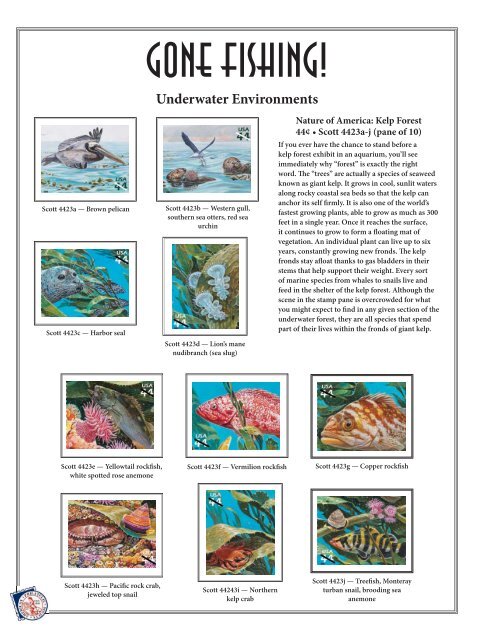Gone Fishing - American Philatelic Society
Gone Fishing - American Philatelic Society
Gone Fishing - American Philatelic Society
You also want an ePaper? Increase the reach of your titles
YUMPU automatically turns print PDFs into web optimized ePapers that Google loves.
<strong>Gone</strong> <strong>Fishing</strong>!Underwater EnvironmentsScott 4423a — Brown pelicanScott 4423c — Harbor sealScott 4423b — Western gull,southern sea otters, red seaurchinScott 4423d — Lion’s manenudibranch (sea slug)Nature of America: Kelp ForestIf you ever have the chance to stand before akelp forest exhibit in an aquarium, you’ll seeimmediately why “forest” is exactly the rightword. The “trees” are actually a species of seaweedknown as giant kelp. It grows in cool, sunlit watersalong rocky coastal sea beds so that the kelp cananchor its self firmly. It is also one of the world’sfastest growing plants, able to grow as much as 300feet in a single year. Once it reaches the surface,it continues to grow to form a floating mat ofvegetation. An individual plant can live up to sixyears, constantly growing new fronds. The kelpfronds stay afloat thanks to gas bladders in theirstems that help support their weight. Every sortof marine species from whales to snails live andfeed in the shelter of the kelp forest. Although thescene in the stamp pane is overcrowded for whatyou might expect to find in any given section of theunderwater forest, they are all species that spendpart of their lives within the fronds of giant kelp.Scott 4423e — Yellowtail rockfish,white spotted rose anemoneScott 4423f — Vermilion rockfishScott 4423g — Copper rockfishScott 4423h — Pacific rock crab,jeweled top snailScott 44243i — Northernkelp crabScott 4423j — Treefish, Monterayturban snail, brooding seaanemone
















